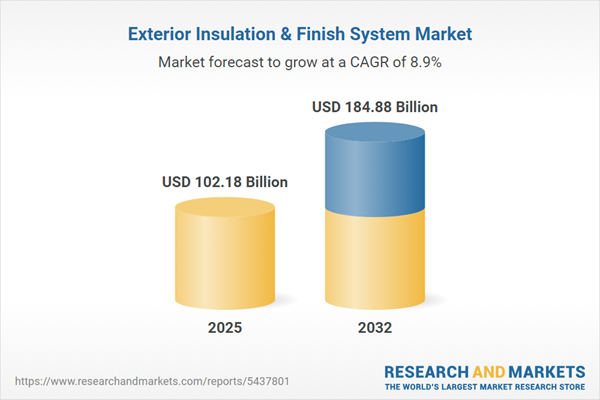Speak directly to the analyst to clarify any post sales queries you may have.
The exterior insulation and finish system (EIFS) market is increasingly prioritized by senior decision-makers seeking construction solutions that drive energy efficiency, support sustainability initiatives, and ensure compliance in diverse property portfolios.
Market Snapshot: Exterior Insulation and Finish System Market
The global exterior insulation and finish system market is exhibiting consistent growth as construction sector regulations around energy efficiency and sustainability continue to advance. Market revenues are projected to rise steadily, fueled by investments in a wide range of construction activities including commercial, residential, industrial, and institutional projects. Heightened urbanization and increased interest in both new construction and retrofitting existing structures create strong demand for EIFS solutions. As organizations focus on building regulation compliance, asset longevity, and adaptation to changing market dynamics, EIFS adoption continues to gain traction across property segments, underscoring the sector’s resilience and widespread integration.
Scope & Segmentation of the EIFS Market
- End Use: Widely used in hospitality, office environments, logistics centers, manufacturing sites, healthcare, educational facilities, and residential developments, EIFS enhances property performance and aligns construction with recognized sustainability standards such as LEED.
- Insulation Material: Options include expanded polystyrene, mineral wool, phenolic foam, polyisocyanurate, and polyurethane, providing tailored solutions for specific thermal performance and fire safety requirements across different projects and regulatory needs.
- Finish Type: Acrylic, silicone, and alternative synthetic finishes help deliver highly durable, low-maintenance exteriors that resist diverse weather conditions and offer long-term protection for various building types.
- Application: Suitable for both new construction and retrofitting, EIFS allows asset owners to improve energy performance or modernize exteriors with minimal disruption to ongoing operations.
- System Type: One-coat and two-coat systems provide flexibility, supporting project-specific requirements related to compliance, scheduling, and resource allocation.
- Distribution Channel: Available through direct sales, distributor partnerships, and retail channels, EIFS systems can be sourced efficiently across organizations of varying sizes, helping to secure reliable procurement and minimize supply disruption.
- Regions: Strongest growth is found in the Americas and Asia-Pacific, where capital influx, reform strategies, and regulatory shifts are significant. In Europe and the Middle East, adoption is driven by increasing environmental requirements and the need for better building energy performance, which is reflected in greater EIFS specification for public and private construction.
- Leading Companies: Competitive innovation and support are led by organizations such as Compagnie de Saint-Gobain SA, BASF SE, The Dow Chemical Company, Sto SE & Co. KGaA, Sika AG, MAPEI SpA, RPM International Inc., Knauf Insulation GmbH, Kingspan Group plc, and Rockwool International A/S.
Key Takeaways for Senior Decision-Makers
- Adoption of advanced insulation and bonding systems enables ongoing compliance with new construction and energy consumption regulations, supporting consistency and building quality across projects.
- Retrofit solutions using EIFS offer a practical route to update aging assets, driving operational efficiency and tangible progress towards broader sustainability and ESG goals.
- The versatility of EIFS simplifies management of large, multi-location property portfolios by facilitating uniform compliance across diverse building types and global regions.
- Integrating recycled or renewable materials into project supply chains strengthens progress toward circular economy principles and reinforces the sustainability credentials of both new and upgraded developments.
- Engagement with a diverse mix of global and regional suppliers helps sustain timely project delivery and provides flexibility to respond to changing regulatory and market conditions.
Tariff Impact: U.S. Supply Chain Considerations
New U.S. tariffs affecting EIFS components are influencing organizations to reassess their supply chain approaches. Companies are deepening relationships with domestic suppliers and renegotiating contracts to lower exposure to risk, promote reliable access to essential materials, and uphold ongoing compliance with project and regulatory timelines.
Methodology & Data Sources
This analysis combines thorough secondary research, in-depth industry interviews, proprietary surveys, current regulatory review, and patent analysis. Conclusions have been validated with industry experts to ensure practical and reliable recommendations for senior executives.
Why This Report Matters
- Enables executives to interpret evolving regulatory frameworks and regional dynamics, allowing for more informed decision-making and portfolio management in the exterior insulation and finish system market.
- Supports confident strategy development for procurement, investment, and benchmarking by highlighting key opportunities and facilitating timely adaptation to market changes.
- Helps teams proactively manage compliance and supply chain challenges as environmental and construction standards become more stringent, aligning decision-making with sustainability and operational risk objectives.
Conclusion
EIFS technologies are playing a vital role in sustainable building practices and long-term asset value retention. This report equips senior leaders with actionable insights for effective investment and project delivery as the market evolves.
Additional Product Information:
- Purchase of this report includes 1 year online access with quarterly updates.
- This report can be updated on request. Please contact our Customer Experience team using the Ask a Question widget on our website.
Table of Contents
3. Executive Summary
4. Market Overview
7. Cumulative Impact of Artificial Intelligence 2025
Companies Mentioned
The companies profiled in this Exterior Insulation & Finish System market report include:- Compagnie de Saint-Gobain SA
- BASF SE
- The Dow Chemical Company
- Sto SE & Co. KGaA
- Sika AG
- MAPEI SpA
- RPM International Inc.
- Knauf Insulation GmbH
- Kingspan Group PLC
- Rockwool International A/S
Table Information
| Report Attribute | Details |
|---|---|
| No. of Pages | 193 |
| Published | November 2025 |
| Forecast Period | 2025 - 2032 |
| Estimated Market Value ( USD | $ 102.18 Billion |
| Forecasted Market Value ( USD | $ 184.88 Billion |
| Compound Annual Growth Rate | 8.8% |
| Regions Covered | Global |
| No. of Companies Mentioned | 11 |









